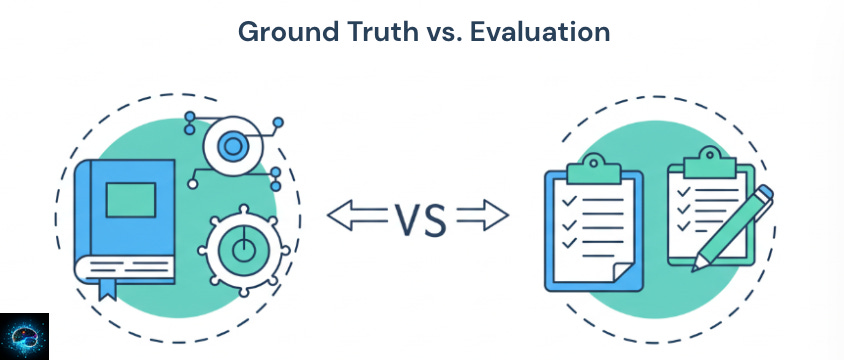Ground Truth vs. Evaluation: Same Data, Different Jobs
Ground Truth builds knowledge. Evaluation builds trust.
A few weeks ago, I found myself knee-deep in evaluation frameworks for LLMs. Everywhere I looked, there were eval suites: hallucination evals, factuality evals, style evals. And my first thought was: isn’t this just ground truth with a fancier name?
That reaction wasn’t random. Back when I was product managing ML systems, ground truth was everything. We’d pour months of effort into collecting and labeling it. Without strong ground truth, your model had nothing to learn from. And looking at today’s eval frameworks, with their labeled prompts and curated gold answers, it all felt oddly familiar.
But here’s what I’ve come to realize: while the activity looks similar, the purpose is completely different. And if you blur that line, you risk burning time on the wrong data, “teaching to the test,” or worse - shipping a system you think is ready when it isn’t.
The Textbook vs. The Exam
Think about it like this: ground truth is the textbook. It’s what the model studies. Evaluations are the exam. They test whether the model actually learned.
Ground truth comes first. It’s created before or during training, and it’s used to shape what the model knows. If you’re training a spam filter, ground truth is the dataset of 50,000 emails carefully labeled “spam” or “not spam.” If you’re fine-tuning a summarization model, it’s the collection of prompts and ideal answers: “Summarize this article in three factual sentences.”
Evaluations, on the other hand, come later. They’re the measure of whether the system can handle new or unseen cases. For the spam filter, that might be a held-out test set of 10,000 emails the model never saw during training. For the summarizer, it’s a suite of prompts designed to see if the model’s answers are not only fluent, but also accurate, safe, and aligned with your product’s style.
Both rely on labels. Both require judgment. But one feeds the model, and the other builds confidence in it.
Why the Distinction Matters
It’s easy to conflate the two, especially in GenAI. After all, both ground truth and evals often involve human raters, labeled examples, and datasets of “right” answers. But the distinction matters because the stakes are different.
Ground truth builds knowledge. Get it wrong, and the model never learns the right patterns.
Evaluation builds trust. Get it wrong, and you’ll ship a product that seems fine on paper but fails in reality.
If you mistake one for the other, you run into real problems. Data leakage happens when your evaluation set sneaks into training, giving you artificially inflated scores. Overfitting happens when you optimize too much for eval results, rather than real-world performance. And false confidence happens when you report “90% accuracy” without realizing you’ve only tested against what the model already memorized.
Where It Gets Messy
The reason my confusion was understandable is because with LLMs, the boundary really does blur. Reinforcement learning from human feedback (RLHF) uses human judgments both as training signals and as evaluation criteria. Annotators often create ground truth datasets and eval sets in the same workflows. And in production, user feedback often flows right back into the training loop.
This overlap isn’t inherently bad; it can even accelerate iteration, but if you lose track of which data is being used for what, you end up with misleading metrics and shaky foundations. It’s like teaching students with past exam papers, then using those same papers to grade them. They’ll ace the test, but you won’t know if they’ve actually learned.
The Takeaway for PMs
As an AI PM, you don’t need to label data yourself, but you do need to keep the distinction clear in your mind and your team’s workflows. Ground truth is what your model learns from. Evaluation is how you know if it’s good enough to ship.
Both matter. Both require investment. But they play very different roles. One builds knowledge. The other builds trust.
And in the end, trust is what separates a great demo from a great product.


